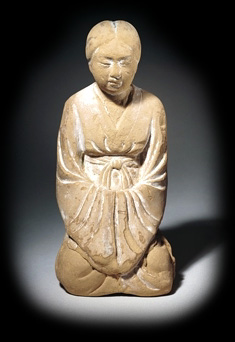

![]()
Kneeling Woman
Nara Prefecture, Horyuji
Nara period, early 8th century
Clay with traces of slip and pigmentThis figurine is believed to be from Horyuji temple in Nara, one of the first and most significant Buddhist temples in Japan, patronized by Prince Shotoku. The woman wears a full-sleeved gown tied at the bodice with a long sash, identical in style to garments seen in contemporaneous Chinese sculptures. Chinese influence on Japan reached a peak in the eighth century, and even Nara, its capital, was modeled after the Chinese capital Xi'an. Japan's desire for international respectability led to the emulation of an urbane, continental culture, represented at the time by China.
Cycles of Artistic Interaction
Japan's relationship to the world has been characterized by cycles of insularity alternating with intense and even aggressive interaction. Its adaptation of foreign cultures sometimes occurred through peaceful association and, more rarely, through military and forcible appropriation. For example, this female clay sculpture from Horyuji temple illustrates the absorption of Chinese prototypes in eighth-century Japanese art. Conversely, the important stoneware traditions of Kyushu during the Momoyama and early Edo periods, as seen in these Karatsu mukozuke dishes, owe much to Japan's imperialist aspirations: the earliest potters were Koreans captured and brought back to Japan following Japan's invasion of Korea in the 1590s.
